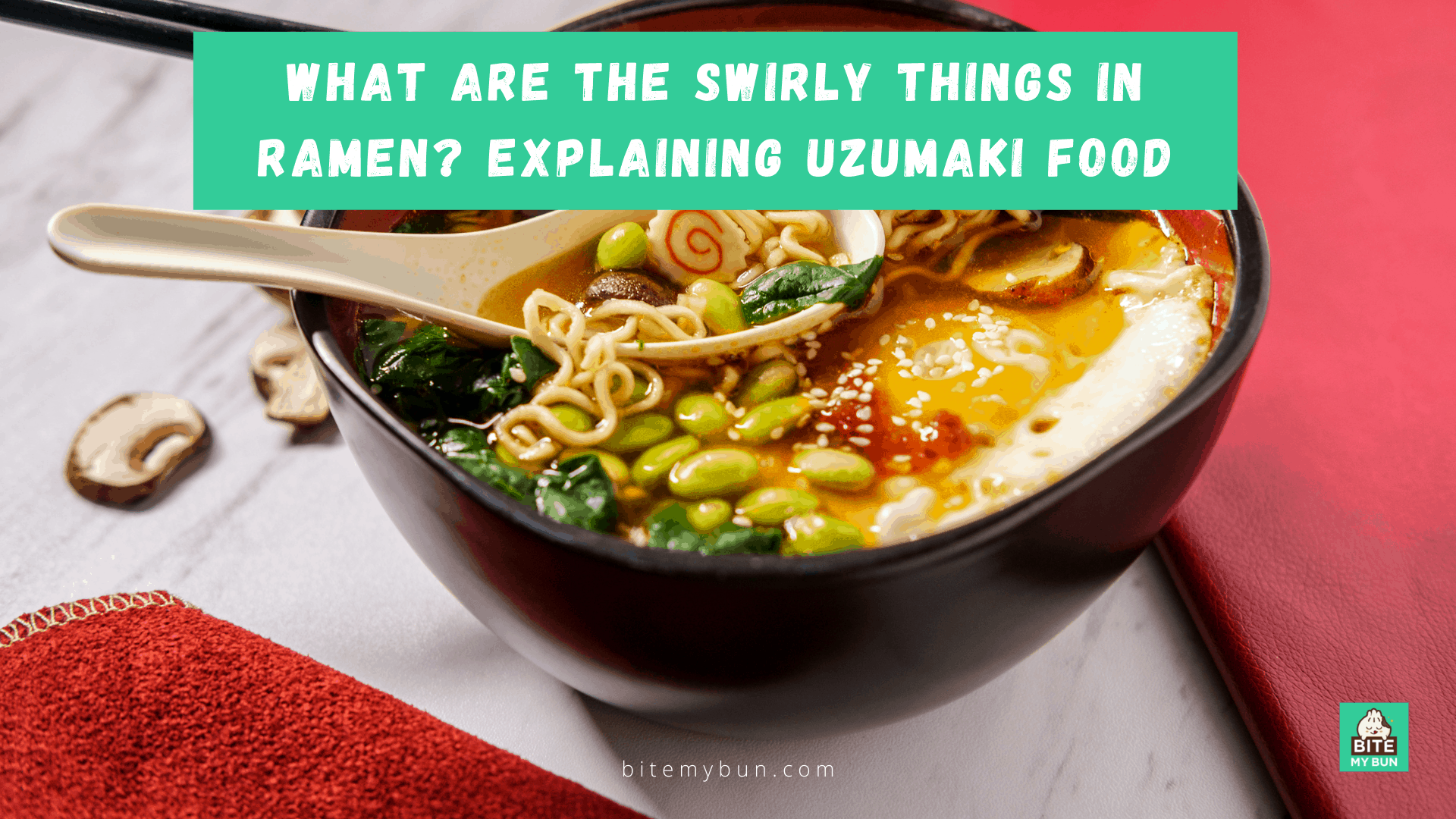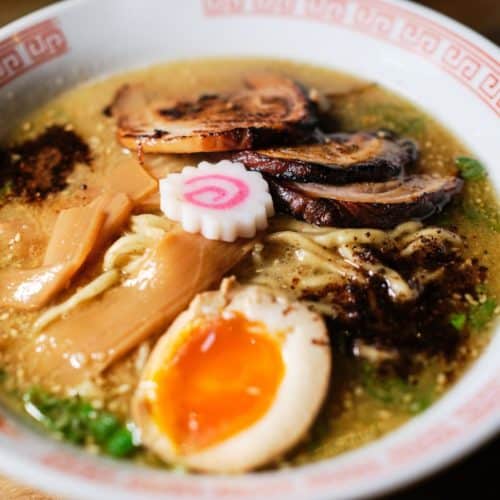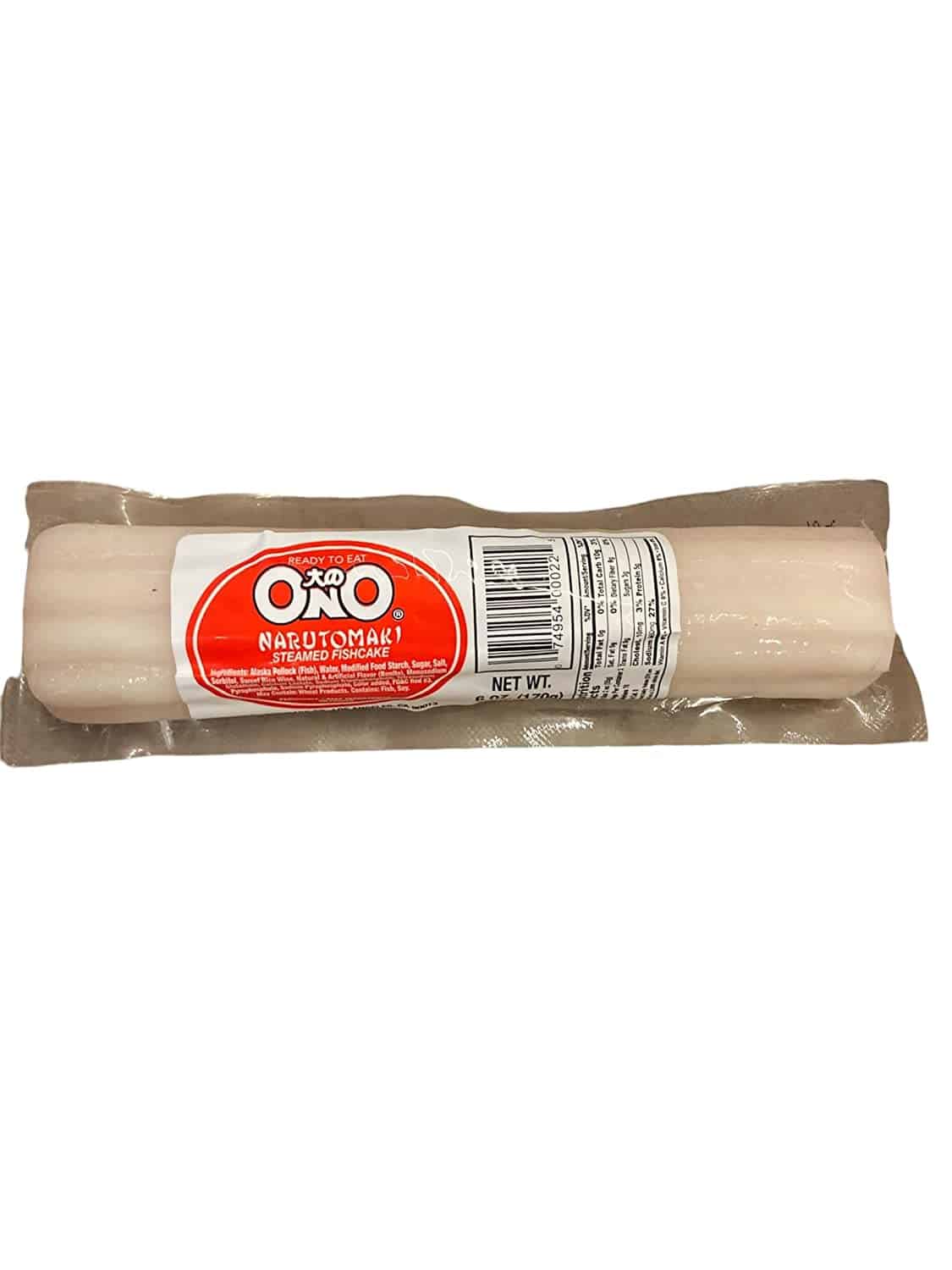Kamaboko In Ramen: The Swirly Things Called Narutomaki
In ramen, a Japanese-based dish using soup broth, udon noodles, vegetables, and a meat/fish of your choice, there is often a small, white swirling thing that goes along with it.
It looks like a whirlpool and is often placed at the side of the dish. What is this swirly thing and what is it doing there?

Its name and function are pretty simple, it is a fish cake called Narutomaki, or Uzumaki if that’s what you prefer. The name, Narutomaki, has no direct English translation, but it is believed to have come from the Naruto whirlpools.
Here is my favorite recipe with kamaboko narutomaki in ramen:


Check out our new cookbook
Bitemybun's family recipes with complete meal planner and recipe guide.
Try it out for free with Kindle Unlimited:
Read for freeIn this post we'll cover:
Kamaboko Ramen Recipe (Narutomaki)
Ingredients
- 25 oz chicken stock (700 ml)
- 3 garlic cloves (halved)
- 4 tbsp soy sauce
- 1 tsp Worcestershire sauce
- Sliced ginger thumb-sized piece
- ½ tsp Chinese five-spice
- 1 pinch chili powder
- 1 tsp white sugar optional
- 13 ounces ramen noodles (375g)
- 14 ounces cooked pork or chicken breast (400g)
- 2 tsp sesame oil
For the garnish
- 3½ ounces baby spinach (100g)
- 4 tbsp sweet corn
- 4 whole boiled eggs peeled and halved
- 1 sheet dried nori
- Sliced green spring onions or shallots
- 1 sprinkle sesame seeds
- 12 slices narutomaki swirly kamaboko
Instructions
- Mix the chicken stock, garlic cloves, soy sauce, Worcestershire sauce, ginger, Chinese five-spice, chili powder, and water (300 ml) in a large saucepan or stockpot. Allow the ingredients to boil and reduce the heat.
- Allow to simmer for around 5 minutes.
- Taste your stock and add a tsp of white sugar or extra soy sauce to make it saltier or sweeter, depending on your preference.
- Next, cook your ramen noodles and make sure that you follow the instructions on the packaging. Drain the noodles and set them aside.
- Slice your pork or chicken, and then fry them in sesame oil (2 tsp) until they start to brown. Set aside.
- Divide your noodles into your bowls and top each portion with ¼ of the meat, 25g spinach, sweet corn (1 tbsp), and 2 halves of boiled eggs.
- Now strain your stock into a clean pan and then boil it again.
- Once the stock's boiled, divide it between these 4 bowls and then sprinkle on the shredded nori sheet, spring onions or shallots, and sesame seeds. Let the spinach wither slightly before serving and add 3 slices of narutomaki on top.
If you want an authentic taste, this Ono narutomaki log is a great choice:

Why are narutomaki called Uzumaki food?
The Naruto whirlpools form off the coast of the Naruto Strait and often have a swirling pattern to them like those found on the Narutomaki.
And for those of you familiar with Japanese anime, yes, the main character from Naruto is named after these whirlpools.
Naruto’s last name is Uzumaki, and his favorite food, as the real fans know, is miso ramen. This is the reason the narutomaki on ramen has become associated with Naruto Uzumaki.
Uzumaki literally means “spiral” in Japanese, which might explain why Naruto likes Narutomaki so much.
However, some say that the reason the anime character is actually called Naruto, because the creator of the series, Masashi Kishimoto, really likes a bowl of ramen with narutomaki on top.
So there. The narutomaki fish cakes are so popular in Japan, that they made it deep into its pop culture, which in turn has made narutomaki even more popular.
Why is narutomaki in ramen?
But, enough about that, why do these little things go on ramen?
Well, this Uzumaki food is like the milkshake to the American Cheeseburger. It’s there as a treat to enjoy or to compliment the ramen as you eat them.
Narutomaki tastes like cured fish, as that’s what it’s made from. It is well known for its fishy taste, texture, and is mainly there to serve as a bright contrast to the otherwise green/brown ramen soup.
Believe it or not, many Japanese dishes also serve as works of art, so that might be one possible reason why they were introduced to ramen in the first place.
Another possible reason is that someone may have just well decided that narutomaki goes good with noodle soup, and it picked up from there.
Naruto, the fish cake, has been served on ramen ever since the end of the Edo period (think the late 1800s to early 1900s) and was also introduced to Chinese soba around the same time.
Also read: is ramen the same as rice noodles? Here’s how ramen’s made
Do you want narutomaki in your ramen?
Now, that raises the question, do you want it on your ramen?
Well, it mostly boils down to personal preference and your taste in fish.
But, let’s go over a few reasons as to whether or not you do, or do not, want narutomaki on your ramen.
Why you wouldn’t
- It reminds you too much of the Naruto anime. A bit of a joke, but it is not impossible to associate the Uzumaki with Naruto, and while the show has many, many fans, it is still possible for a person to dislike it.
- You dislike the taste of fish. This one is simple. Narutomaki is made of fish, and not everyone likes fish.
- The narutomaki may clash with your dish. Both in aesthetics and tastes, the swirly fish cakes may not compliment your food. Due to its fishy taste, narutomaki may not go well with your chicken or broth.
- It may not be served with your ramen. Surprisingly, or unsurprisingly if you’re already aware, narutomaki may not be served at your local ramen shop, as it has fallen out of service for a while. But it is still widely popular, so they may just have it in reserve.
Why you would
- You’re a fan of the Naruto anime. In the inverse of the above, it’s completely possible to learn about Narutomaki just from the Naruto anime and come to enjoy the taste because of it. Or you have positive connections to the show, and enjoy ramen because of it.
- You may like the taste of fish.
- The narutomaki goes well with your dish of choice. As said before, many Japanese dishes tend to be visually pleasing to the eye, and while that’s not true for every chef or store, the fact remains that the brightly colored Uzumaki contrasts nicely with the darker colors of the ramen.
- It may be served with your ramen. In direct contrast to the above, many ramen shops do have narutomaki listed on their menu and go well with the ramen served. The fishy taste offering a nice addition to the meal.
Conclusion
As said, narutomaki’s placement in your dish boils down mostly to personal preference. It can be good, it can be bad, or it can be non-existent in any ramen soup.
The best advice that can be given is that, if it is to your liking, then feel free to add it. If not, then don’t worry about it. So, yeah, what goes well for you, may not be so great for another person.
Narutomaki is something of a strange addition to the meal if only because while it’s not a bad thing to have, you’re not missing it if you don’t want it.
It’s a bit like a heated seat in a car, nice to have, but it can be annoying if you don’t want to have it.
Narutomaki, or Uzumaki as we now know, are well known for their bright color, taste, and their namesake in pop culture. Which probably boosted sales once the connection was made.
If you’re interested or pleased by its history, then go give it a try. If it is not to your liking, then don’t worry about it.
Read next: this is how you can reduce the amount of sodium in ramen
Check out our new cookbook
Bitemybun's family recipes with complete meal planner and recipe guide.
Try it out for free with Kindle Unlimited:
Read for freeJoost Nusselder, the founder of Bite My Bun is a content marketer, dad and loves trying out new food with Japanese food at the heart of his passion, and together with his team he's been creating in-depth blog articles since 2016 to help loyal readers with recipes and cooking tips.
